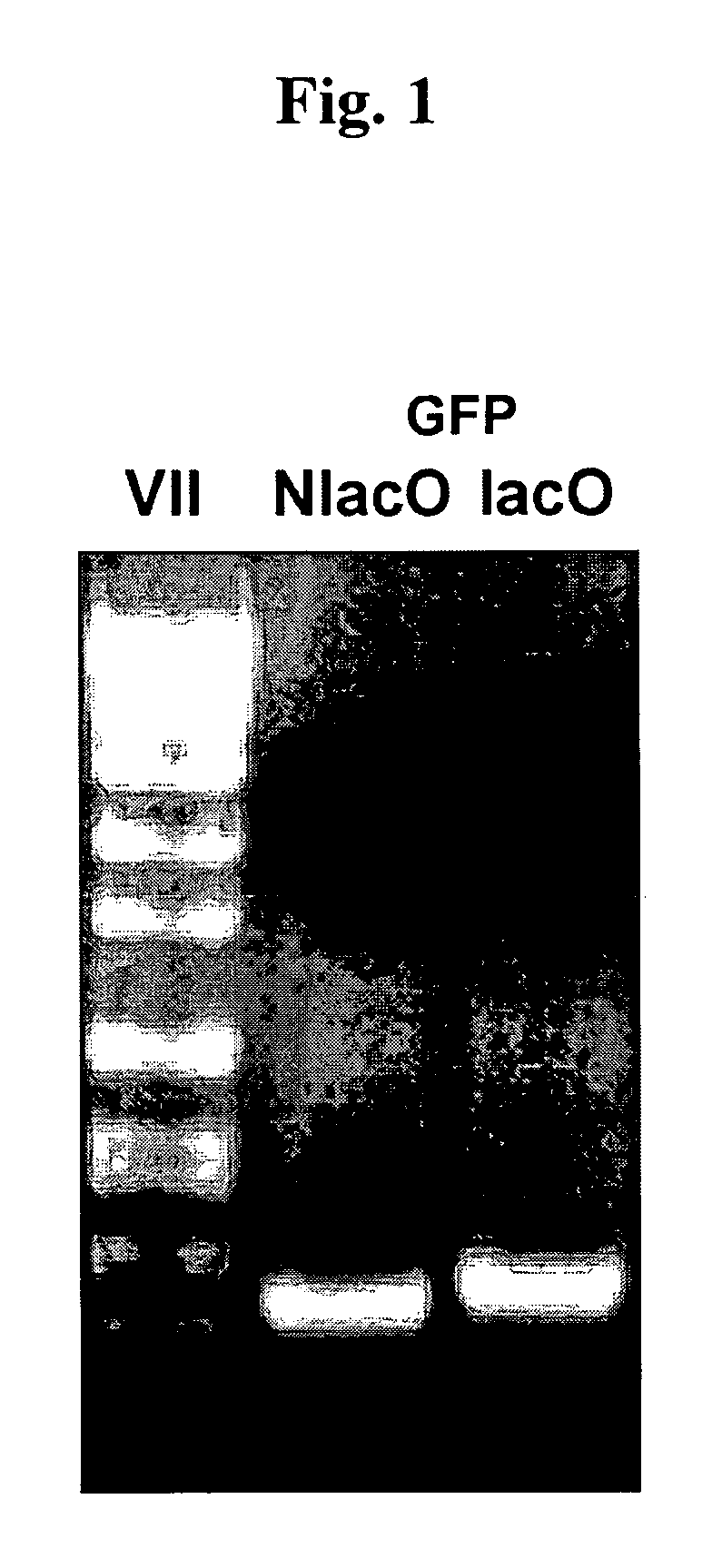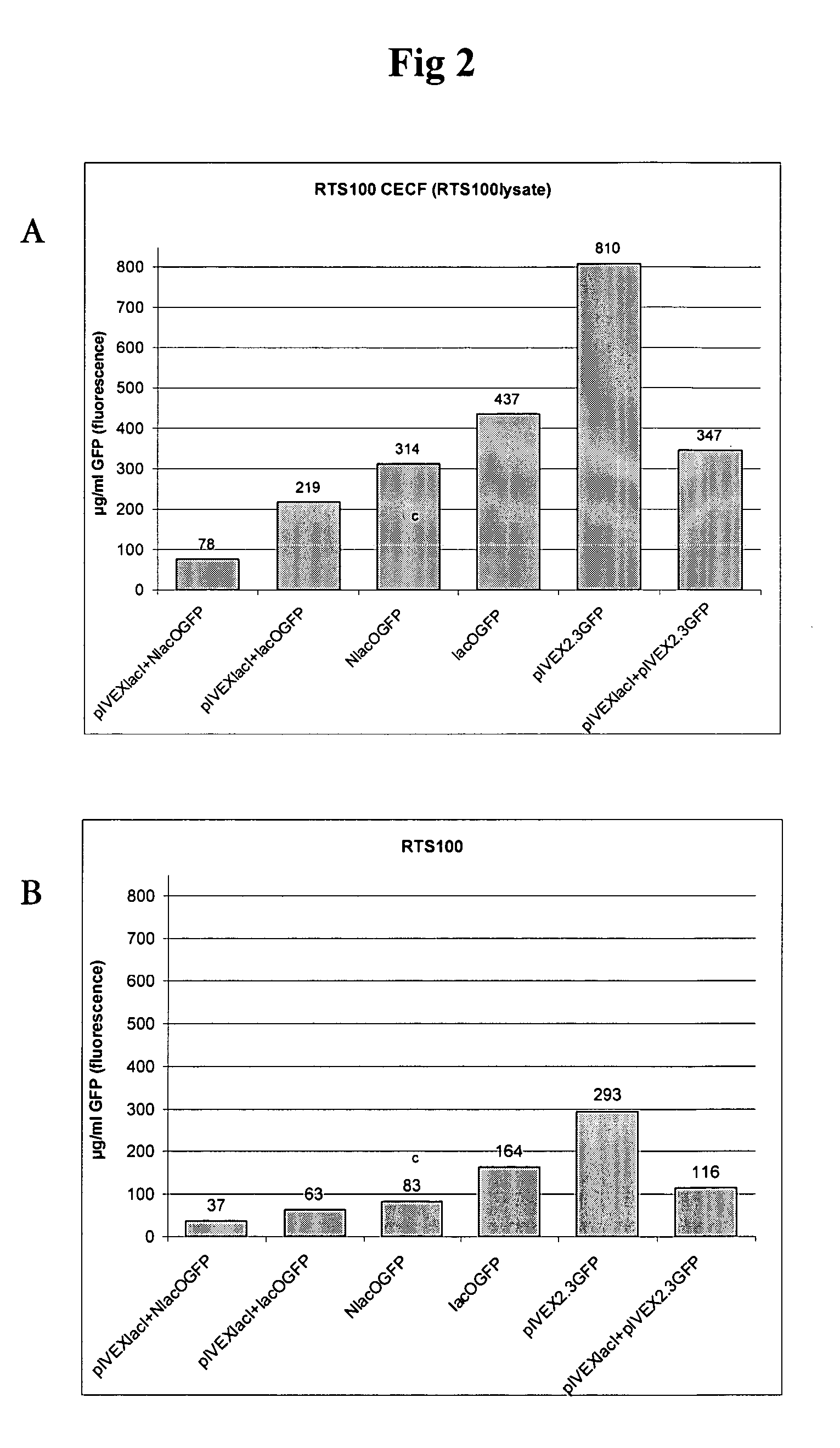Stabilization of linear double-stranded DNA in the presence of exonucleases
- Summary
- Abstract
- Description
- Claims
- Application Information
AI Technical Summary
Benefits of technology
Problems solved by technology
Method used
Image
Examples
example 1
Production of a Double-Stranded Linear DNA
[0053] To assess the stabilizing effect of the Lac repressor on a linear DNA molecule containing a Lac operator sequence on both ends of the molecule, a DNA fragment according to SEQ ID NO:12 with the gene for GFP (green fluorescent protein) was amplified from pIVEX2.3GFP (FIG. 1) using in separate amplification reactions the two primer pairs lacOs / lacOr (SEQ ID NO:14 and SEQ ID NO:15) and NlacOs / NlacOr (SEQ ID NO:16 and SEQ ID NO:17). The fragment corresponded to the DNA fragment generated by means of the RTS (rapid translation system) Linear Template Generation Set (LTGS, His-tag; Roche Diagnostics GmbH, Mannheim, Cat.No.: 3186237) and contained all necessary elements for in vitro transcription / translation. One fragment was amplified using primers with the same sequence as the standard outer primers from the LTGS plus additional 10 bases at the 5′-end. As a control, a second fragment with a pair of primers containing additional 21 bases o...
example 2
Double-Stranded Linear DNA in a Cell-Free Reaction Mixture for Coupled Transcription and Translation Containing Exonucleases
[0054] 3 μl aliquots of each PCR were incubated in 50 μl of the RTS 100 HY transcription / translation mixture according to the manufacturer's protocol (30° C.) both in batch and continuous exchange (CECF) mode. For the CECF reactions 1 ml of the feeding solution from the RTS 500 HY kit was used.
[0055] For co-expression of the LacI protein, 3 μg / ml of the vector pIVEXlacI was added to the reaction, while control reactions contained no pIVEXlacI vector (i.e. the Lacd coding sequence comprised in SEQ ID NO:13 inserted into the pIVEX vector). Finally 10 μg / ml of the original expression vector pIVEX2.3GFP was used as control with and without coexpression of LacI.
[0056] The batch reactions were run for 4 h without shaking, while the CECF reactions were incubated for 6 h with shaking at 900 rpm in the ProteoMaster instrument. After incubation the reactions were kept...
example 3
Comparison of Yield
[0057] As shown in FIG. 3 the differences in yield quantified by measuring GFP fluorescence were confirmed by Western blotting. The presence of the lac operator sequence in the PCR fragments resulted in a significant increase in yield compared to the unprotected fragments, both in batch (left side of FIG. 3) and CECF mode (right side of FIG. 3). An increase of about 90% in batch and 40% in CECF reactions without co-expression show the stabalizing effect of the Lacd protein already present in the lysate. Co-expression leads to lower absolute yields but to higher relative differences between protected and unprotected fragments.
PUM
| Property | Measurement | Unit |
|---|---|---|
| Stability | aaaaa | aaaaa |
Abstract
Description
Claims
Application Information
 Login to View More
Login to View More - R&D
- Intellectual Property
- Life Sciences
- Materials
- Tech Scout
- Unparalleled Data Quality
- Higher Quality Content
- 60% Fewer Hallucinations
Browse by: Latest US Patents, China's latest patents, Technical Efficacy Thesaurus, Application Domain, Technology Topic, Popular Technical Reports.
© 2025 PatSnap. All rights reserved.Legal|Privacy policy|Modern Slavery Act Transparency Statement|Sitemap|About US| Contact US: help@patsnap.com



